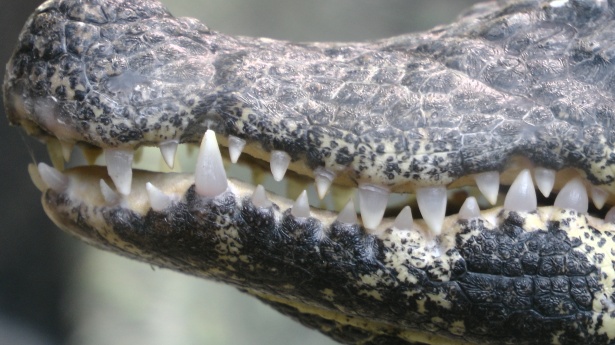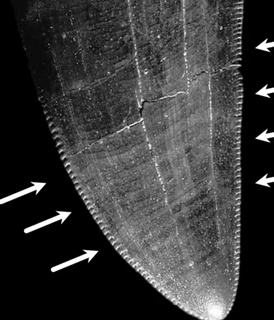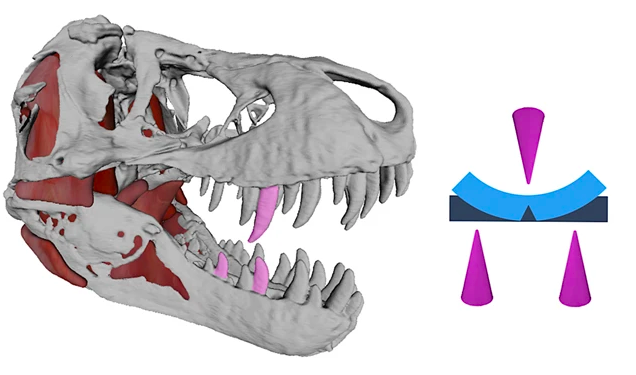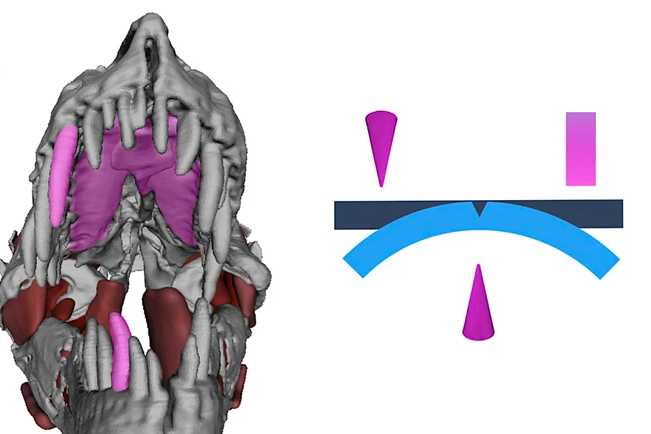There has been much debate regarding the maximum speed of T. rex and indeed if T. rex could even run. Some studies have suggested that it may have been able to reach speeds of up to 20m/s (72 km/hr) based on the length and musculature of its legs (Sellers et al. 2017). However, other researchers have suggested that it is unlikely that T. rex could have achieved this speed because of the 'scaling principle', which basically states that as muscles get larger they do not produce proportionally as much force (Sellers et al. 2017). What this means is that even though the leg muscles may appear massive, the amount of force the muscles generate is much lower than what would be expected for their size.
However, the problem with trying to estimate the running speed of T. rex based on its musculature is that soft tissue, such as muscle, is not well fossilized. Therefore, this method is imprecise (Sellers et al. 2017).
Consequently, another method that has been proposed by Sellers et al. (2017) is to examine the bones—which do fossilize well—and try to estimate how much force the bones could have taken, in life, without fracturing (Sellers et al. 2017). The idea behind this is that as an animal runs faster, the amount of force being applied to the leg bones also increases (Sellers et al. 2017). As such, the faster an animal runs, the stronger its bones should be. Therefore, determining how strong the bones are should provide an estimate as to how fast that animal can run.
Animals that are alive today typically only apply 25-50% of the force required to break bones, onto their bones (Sellers et al. 2017). Assuming that the same rule applied to T. rex, the authors used machine learning to determine that T. rex would not have been able to run at high speeds without fracturing its leg bones (Sellers et al. 2017). Instead they suggest that instead of running as we typically think of it, T. rex would have moved faster by using a more bird style form of running which puts less stress on the bones (Sellers et al. 2017).
However, the authors acknowledge that the machine learning model that they used may not be providing a completely accurate estimate of running speed because it does not take soft tissues such as muscles and tendons/ligaments into account (Sellers et al. 2017). The problem with not taking these soft tissues into account, is that tendons and muscles can actually allow for faster running speeds as these tissues help to reduce stress on the bones (Sellers et al. 2017).
Putting maximum running speed aside, another group of scientists attempted to determine the average walking speed of T. rex using something called the Natural Frequencies Method (van Bijlert et al. 2021). The idea of this method is that animals will likely optimize their movements to be the most energy efficient and so therefore the most energy efficient walking speed is probably also the speed at which an animal will usually move (van Bijlert et al. 2021). The way to find the optimal frequencies, as laid out by the authors of the paper, is to look for the frequencies of motion of body parts that are used in locomotion (van Bijlert et al. 2021). What this means is that the authors tried to determine how fast a part of the animal—the tail for example—might 'bob' up and down, which will provide a clue as to how fast an animal moves. In fact, the authors actually did look at the tail and noted that as the muscles of the hamstrings contracted, they would pull down on the tail. This would therefore create an up and down "bobbing" motion of the tail as T. rex walked (van Bijlert et al. 2021). Based on this, they determined that T. rex's maximum normal walking speed was probably around 1.28m/s (4.6km/hr) (van Bijlert et al . 2021).
However, the authors did note that if T. rex stiffened its tail by contracting its tail muscles, it would mean that the tail would have a higher natural frequency (would bob up and down faster) which could allow for faster speeds (van Bijlert et al. 2021)
The authors did provide an animation of this tail movement, which can be found below as well as in their original paper.
Scientists looking at the coprolites (poop) of T. rex also noticed something interesting about its feeding technique. They noticed that it was able to crush bone into very small slivers (Gignac and Erickson 2017). This may seem obvious to us, but this actually reveals something interesting about the bite of T. rex. For context, mammals can crush bone into small pieces because their teeth are occluding (Gignac and Erickson 2017). This means that the upper teeth (maxillary) and lower teeth (mandibular teeth) line up so that when the mouth is closed, the surfaces of the the teeth touch each other. This allows for any material that happens to be between the teeth to be crushed into small pieces.
In contrast, crocodilians, which are one of the closest relatives of dinosaurs, have teeth that do not occlude (Gignac and Erickson 2017). This means that even though crocodilians are able to generate bone crushing bite pressures, they are not able to break the bone into small pieces (Gignac and Erickson 2017). As such, crocodilians tend to swallow large chunks of bone and meat at a time (Gignac and Erickson 2017).

Similar to crocodilians, T. rex also has non-occluding teeth which should mean that the bone fragments found in T. rex coprolites should be large. This made the discovery of finely bone fragments in the T. rex comprolites to be quite surprising.
Closer examination of the teeth of T. rex seems to provide the answer. The scientists noted that the dental structure of T. rex promoted fractures that span between teeth and that the teeth are arranged in such a way as to promote bone breakage (Gignac and Erickson 2017).
If we look closely at a T. rex tooth we notice the 'carinae' (which are the famous serrated edges of the teeth). The scientists realized that these carinae were aligned with each other and act as a further wedge so that as a tooth bites into bone, the carinae help to finely tune the fracture that the tooth produces, so that it continues in the direction of the adjacent tooth - which helps to break the bone into thinner pieces (Gignac and Erickson 2017).




There have been many hypotheses put forward trying to explain why the arms of T. rex are so small. These range from being used for display/mating, to grasp prey at close range, and to help push a T. rex up from a sitting position (Padian 2022).
An interesting hypothesis that Padian (2022) puts forward is that the arms of T. rex were so small in order to avoid being bitten by other T. rex during feeding frenzies.
The author of this hypothesis first summarized some of the old hypotheses used to explain why T. rex had such small arms and then points out the flaws in these arguments.
Firstly, Padian (2022) looks at the idea that the small arms may have been a form of sexual or social display similar to how a peacock uses its tail to advertise his suitability to peahens. However, Padian (2022) remarks that usually structures that are used for social displays tend to be large in order to attract attention, not small like in the case of T. rex arms.
Another idea that has been suggested is that the small arms were useful in holding down prey. They state that this is unlikely to be a reasonable answer because the arms were only able to produce about 400lbs (approximately 200kg) of force which would not be enough to hold down the large dinosaurs that T. rex likely preyed on (Padian 2022).
Related to the idea of T. rex using its arms to hold down prey is the hypothesis that the arms were used for stabbing prey. However, Padian (2022) suggests that the size of the arms once again prevents them from being optimal for this job since by the time that the arms are within striking distance of the prey, the jaws would already be around the prey and would be able to cause much more damage than anything the arms could do.
Secondly, the idea of being used during mating also appears unreasonable for the same reasons. Padian (2022) suggests that such small and relatively weak arms would probably not be useful to hold onto another T. rex (Padian 2022).
In regards to the arms being used to help push T. rex up from a sitting position, the author suggests that even if they could be used for this task, this does not explain why the arms shrank in the first place—as it would seem that larger arms would naturally be better at this job than smaller arms (Padian 2022).
Another factor that is pointed out, which has ramifications for many of the hypotheses put forward thus far, is that the arms of T. rex, regardless of size or strength, likely had limited mobility which would have severely hampered their ability to be useful in social/sexual displays, or grasping/stabbing prey (Padian 2022).
Instead, the hypothesis that Padian (2022) puts forth is that the small arms were actually selected for, because larger arms would have been a liability to adults feeding on the same carcass. This is because during a feeding frenzy, larger arms could be bitten by other adults indiscriminantly feeding from the same carcass (Padian 2022). As an analogy, the author points to how crocodiles often bite each other during a feeding frenzy.
Although this hypothesis seems improbable, Padian (2022) puts forward a number of ways that this feeding frenzy hypothesis could be tested–although,unfortunately, Padian (2022) was not able to test the hypothesis in this paper. Firstly, they suggest examining T. rex skeletons to look for a pattern where parts of the T. rex skeleton that would be closer to the carcass while feeding would be smaller than expected, while parts further away from a carcass would be more proportional in size to the rest of the T. rex (Padian 2022). Secondly, the author suggests that if T. rex adults did bite each other while feeding, there should be greater evidence of damage to body parts that are not tucked close to the body as compared to body parts that are tucked in to the body (Padian 2022). Thirdly, that the functionality of the reduced arms should be less than in dinosaurs with unreduced arms (Padian 2022). The idea being that because the arms became smaller, at the expense of functionality, to avoid being bitten, they should be less useful than the arms of dinosaurs with more proportionally sized arms. Fourthly, given that younger and thus smaller Tyrannosaurs would likely be excluded from the feeding frenzy of adults, their skeletons should have fewer signs of injury from other Tyrannosaurs as they wouldn't be fighting with the larger and presumably more agressive adults for food (Padian 2022). Fifthly, given that the small arms are considered to be a trait of larger Tyrannosaur species, smaller 'ancestors' of these large Tyrannosaur species should not have the same kind of damage to their skeletons as seen in larger species (Padian 2022).
First published on: Sept. 12, 2023.